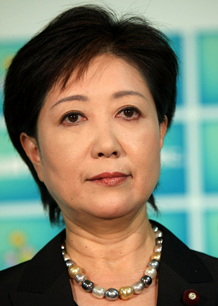| Yuriko Koike | |
| 7th President of Japan | |
| In office:
January 20, 2012 - | |
| Preceded by: | Junichiro Koizumi |
| Succeeded by: | Incumbent |
| 43rd Prime Minister of Japan | |
| In office:
December 31, 1999 - December 31, 2011 | |
| Preceded by: | Junichiro Koizumi |
| Succeeded by: | Maya Murata |
| Minister of the Environment | |
|
In office:
| |
| Preceded by: | Unknown |
| Succeeded by: | Unknown |
|
Member of Assembly from Tokyo (19) | |
| In office:
June 1, 1992 - December 31, 2011 | |
| Preceded by: | |
| Succeeded by: | |
| Biography | |
| Born: |
July 15 1952, Ashiya, Hyogo |
| Birth name: | Koike Yuriko |
| Nationality: | Japanese |
| Political party: | Democratic |
| Spouse: | Divorced |
| Children: |
None |
| Alma mater: | Nehru University |
| Occupation: | Journalist, Politician |
| Religion: | None |
Yuriko Koike was Japan's longest serving, youngest post war and first woman prime minister. She was also the most electorally successful Japanese politician ever, winning three landslide election victories.
After being elected to the Assembly just days after her 40th birthday she served constantly in cabinet posts throughout her congressional career.
In 1999 she was elected leader of the Democratic Party, and became prime minister.
Her government gave unwavering support to Free Market Capitalism, ecological responsibility, anti-Communism and privatisation.
Yuriko Koike was born on July 15th 1952 in Ashiya. Her father, Yujiro, was an oil investor and was keen to see Yuriko grow up to be a successful business woman. She attended her local high school, and in 1972 left Japan to study business at Nehru University in Delhi, India. Whilst their she met Rajiv Singh, and Indian student. Following the completion of her studies in 1974 the two got married and honeymooned in Tokyo. Koike then got a job with Tokyo Today newspaper as their India correspondent. The job was not well paid, but her detailed articles soon drew the attention fo the editor and she soon returned to Japan as a political columnist.
In 1977 Yuriko divorced Singh, citing being unable to maintain a long distance relationship. In 1980 she was hired by TBS as a political correspondent, and in 1984 became their political editor. In 1988 she was given her own political talk show, and it ran for four seasons. In 1990 she announced her intention to seek election to the Japanese assembly at the 1992 general election, but she refused to declare for which party. In September 1991 she resigned her job to concentrate on her political campaign, announcing her support for the democratic party. The next day she was endorsed as a candidate. She was subsequently elected at the 1992 election.
As soon as she entered congress she was made minister of women by Prime Minister Miyazawa. She was instrumental in improving gender equality in Japanese society. Following the 1996 election she was made minister of the environment by prime minister Hashimoto. In this position she pushed for the modernisation of Japan's aging nuclear power plants. She become one of the most popular members of Hashimoto's government, and was briefly thought of as his successor. But when Hashimoto did resign in August 1999, he was succeeded by Junichiro Koizumi.
From the moment he entered office Koizumi declared his intention to succeede the retiring Miyazawa in the office of President, something he was elected to in October 1999. The race then began for his successor. Koike faced over 20 other candidates, being elected by a narrow margin to become party leader and prime minister.
Koike took the oath of office as prime minister on December 31st 1999, an hour before setting off for the millennium celebrations.

